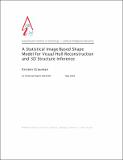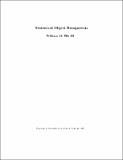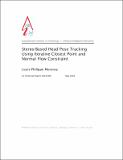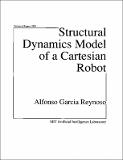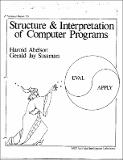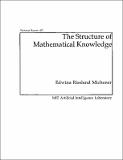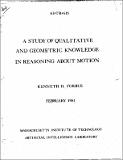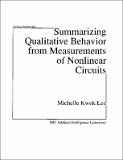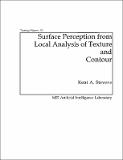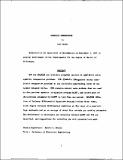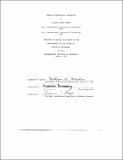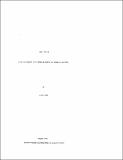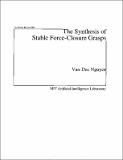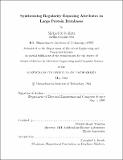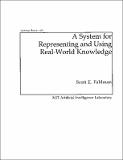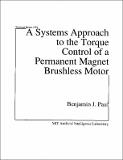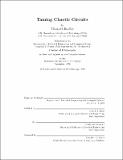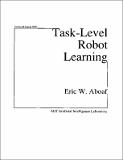Browsing AI Technical Reports (1964 - 2004) by Title
Now showing items 268-287 of 327
-
A Statistical Image-Based Shape Model for Visual Hull Reconstruction and 3D Structure Inference
(2003-05-22)We present a statistical image-based shape + structure model for Bayesian visual hull reconstruction and 3D structure inference. The 3D shape of a class of objects is represented by sets of contours from silhouette ... -
Statistical Object Recognition
(1993-01-01)Two formulations of model-based object recognition are described. MAP Model Matching evaluates joint hypotheses of match and pose, while Posterior Marginal Pose Estimation evaluates the pose only. Local search in pose ... -
Stereo-Based Head Pose Tracking Using Iterative Closest Point and Normal Flow Constraint
(2003-05-01)In this text, we present two stereo-based head tracking techniques along with a fast 3D model acquisition system. The first tracking technique is a robust implementation of stereo-based head tracking designed for ... -
Structural Dynamics Model of a Cartesian Robot
(1985-10-01)Methods are developed for predicting vibration response characteristics of systems which change configuration during operation. A cartesian robot, an example of such a position-dependent system, served as a test case ... -
Structure and Interpretation of Computer Programs
(1983-07-01)"The Structure and Interpretation of Computer Programs" is the entry-level subject in Computer Science at the Massachusetts Institute of Technology. It is required of all students at MIT who major in Electrical ... -
The Structure of Mathematical Knowledge
(1978-08-01)This report develops a conceptual framework in which to talk about mathematical knowledge. There are several broad categories of mathematical knowledge: results which contain the traditional logical aspects of ... -
A Study of Qualitative and Geometric Knowledge in Reasoning about Motion
(1981-02-01)Reasoning about motion is an important part of our commonsense knowledge, involving fluent spatial reasoning. This work studies the qualitative and geometric knowledge required to reason in a world that consists of ... -
Summarizing Qualitative Behavior from Measurements of NonlinearsCircuits
(1989-05-01)This report describes a program which automatically characterizes the behavior of any driven, nonlinear, electrical circuit. To do this, the program autonomously selects interesting input parameters, drives the circuit, ... -
Surface Perception from Local Analysis of Texture and Contour
(1980-02-01)The visual analysis of surface shape from texture and surface contour is treated within a computational framework. The aim of this study is to determine valid constraints that are sufficient to allow surface orientation ... -
Surface Reflectance Recognition and Real-World Illumination Statistics
(2002-10-01)Humans distinguish materials such as metal, plastic, and paper effortlessly at a glance. Traditional computer vision systems cannot solve this problem at all. Recognizing surface reflectance properties from a single ... -
Switching Between Discrete and Continuous Process Models to Predict Molecular Genetic Activity
(1984-05-01)Two kinds of process models have been used in programs that reason about change: Discrete and continuous models. We describe the design and implementation of a qualitative simulator, PEPTIDE, which uses both kinds of ... -
Symbolic Integration
(1967-09-01)SIN and SOLDIER are heuristic programs in LISP which solve symbolic integration problems. SIN (Symbolic INtegrator) solves indefinite integration problems at the difficulty approaching those in the larger integral ... -
Symbolic Mathematical Laboratory
(1967-01-01)A large computer program has been developed to aid applied mathematicians in the solution of problems in non-numerical analysis which involve tedious manipulations of mathematical expressions. The mathematician uses ... -
Syntax-Based Analytic Reading of Musical Scores
(1967-04-01)As part of a larger research project in musical structure, a program has been written which "reads" scores encoded in an input language isomorphic to music notation. The program is believed to be the first of its kind. ... -
The Synthesis of Stable Force-Closure Grasps
(1986-07-01)This thesis addresses the problem of synthesizing grasps that are force-closure and stable. The synthesis of force-closure grasps constructs independent regions of contact for the fingertips, such that the motion of ... -
Synthesizing Regularity Exposing Attributes in Large Protein Databases
(1993-05-01)This thesis describes a system that synthesizes regularity exposing attributes from large protein databases. After processing primary and secondary structure data, this system discovers an amino acid representation ... -
A System for Representing and Using Real-World Knowledge
(1977-12-01)This report describes a knowledge-base system in which the information is stored in a network of small parallel processing elements ??de and link units ??ich are controlled by an external serial computer. This network ... -
A Systems Approach to the Torque Control of a Permanent Magnet Brushless Motor
(1987-08-01)Many approaches to force control have assumed the ability to command torques accurately. Concurrently, much research has been devoted to developing accurate torque actuation schemes. Often, torque sensors have been ... -
Taming Chaotic Circuits
(1992-09-01)Control algorithms that exploit chaotic behavior can vastly improve the performance of many practical and useful systems. The program Perfect Moment is built around a collection of such techniques. It autonomously ... -
Task-Level Robot Learning
(1988-08-01)We are investigating how to program robots so that they learn from experience. Our goal is to develop principled methods of learning that can improve a robot's performance of a wide range of dynamic tasks. We have ...

